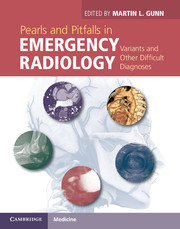Book contents
- Frontmatter
- Contents
- List of contributors
- Preface
- Acknowledgments
- Section 1 Brain, head, and neck
- Section 2 Spine
- Section 3 Thorax
- Section 4 Cardiovascular
- Section 5 Abdomen
- Section 6 Pelvis
- Section 7 Musculoskeletal
- Section 8 Pediatrics
- Case 89 Thymus simulating mediastinal hematoma
- Case 90 Foreign body aspiration
- Case 91 Idiopathic ileocolic intussusception
- Case 92 Ligamentous laxity and intestinal malrotation in the infant
- Case 93 Hypertrophic pyloric stenosis and pylorospasm
- Case 94 Retropharyngeal pseudothickening
- Case 95 Cranial sutures simulating fractures
- Case 96 Systematic review of elbow injuries
- Case 97 Pelvic pseudofractures: normal physeal lines
- Case 98 Hip pain in children
- Case 99 Common pitfalls in pediatric fractures: ones not to miss
- Case 100 Non-accidental trauma: neuroimaging
- Case 101 Non-accidental trauma: skeletal injuries
- Index
- References
Case 95 - Cranial sutures simulating fractures
from Section 8 - Pediatrics
Published online by Cambridge University Press: 05 March 2013
- Frontmatter
- Contents
- List of contributors
- Preface
- Acknowledgments
- Section 1 Brain, head, and neck
- Section 2 Spine
- Section 3 Thorax
- Section 4 Cardiovascular
- Section 5 Abdomen
- Section 6 Pelvis
- Section 7 Musculoskeletal
- Section 8 Pediatrics
- Case 89 Thymus simulating mediastinal hematoma
- Case 90 Foreign body aspiration
- Case 91 Idiopathic ileocolic intussusception
- Case 92 Ligamentous laxity and intestinal malrotation in the infant
- Case 93 Hypertrophic pyloric stenosis and pylorospasm
- Case 94 Retropharyngeal pseudothickening
- Case 95 Cranial sutures simulating fractures
- Case 96 Systematic review of elbow injuries
- Case 97 Pelvic pseudofractures: normal physeal lines
- Case 98 Hip pain in children
- Case 99 Common pitfalls in pediatric fractures: ones not to miss
- Case 100 Non-accidental trauma: neuroimaging
- Case 101 Non-accidental trauma: skeletal injuries
- Index
- References
Summary
Imaging description
Skull radiographs may still be performed to evaluate for pediatric calvarial fractures. However, at most facilities, radiography has been replaced by CT due to its superior detection and characterization of fractures and sutures, and assessment of intracranial pathology. Even on CT, calvarial fractures may be difficult to identify because of the thin cortex in children. Three-dimensional shaded surface reconstructions of the skull (3D-CT) are invaluable to evaluate for pediatric head trauma [1–3]. This technique offers exquisite detail in characterizing surface anatomy and the osseous defect(s) in question. MRI provides no significant advantage over CT to distinguish fractures from normal sutures.
Common sutures include the midline sagittal and metopic, and bilateral coronal and lambdoid. Accessory sutures are most common in the parietal and occipital bones. The parietal bone arises from two ossification centers, while the occipital bone ossifies from six centers [1, 2, 4, 5].
Information
- Type
- Chapter
- Information
- Pearls and Pitfalls in Emergency RadiologyVariants and Other Difficult Diagnoses, pp. 341 - 343Publisher: Cambridge University PressPrint publication year: 2013
